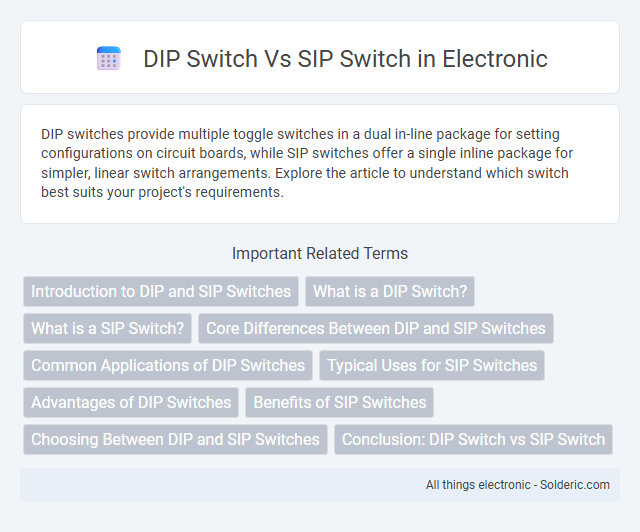DIP switches provide multiple toggle switches in a dual in-line package for setting configurations on circuit boards, while SIP switches offer a single inline package for simpler, linear switch arrangements. Explore the article to understand which switch best suits your project's requirements.
Comparison Table
| Feature | DIP Switch | SIP Switch |
|---|---|---|
| Definition | Dual In-line Package switch with multiple toggle switches in a single package | Single In-line Package switch with a single row of switches |
| Switch Count | Multiple switches (usually 2-12) | Usually fewer switches, often 1-8 in a single line |
| Form Factor | DIP, dual rows of pins | SIP, single row of pins |
| Mounting Type | Through-hole or surface mount | Typically through-hole |
| Common Applications | Setting hardware configurations, addressing, and enabling/disabling features | Simple ON/OFF control, address settings in compact devices |
| Size | Generally larger due to dual rows | More compact due to single row |
| Complexity | Suitable for complex settings (multiple switches) | Simple switch configurations |
| Cost | Typically higher due to more switches | Lower cost for fewer switches |
Introduction to DIP and SIP Switches
DIP switches and SIP switches are types of manual electronic switches used to configure settings directly on a circuit board. DIP switches consist of multiple individual toggle switches housed in a dual in-line package, making them ideal for setting multiple binary options in compact spaces. SIP switches feature a single inline package with switches arranged linearly, offering straightforward, space-saving configuration for your electronic devices.
What is a DIP Switch?
A DIP switch is a manual electric switch packaged in a dual in-line package (DIP) configuration, commonly used to configure settings on electronic devices. It consists of multiple small switches that can be toggled on or off to control circuit functions, making it ideal for setting hardware options or device addresses. Your choice of DIP switches ensures precise and reliable control in embedded systems, offering a compact and cost-effective solution for hardware customization.
What is a SIP Switch?
A SIP switch, or Single Inline Package switch, is a compact type of manual switch commonly used in electronic devices for setting configurations or modes. It consists of a row of switches in a single line, designed for easy circuit board integration and simplified control of multiple settings through binary on/off states. SIP switches are favored for their space-saving design compared to DIP (Dual Inline Package) switches, which have two parallel rows of switches.
Core Differences Between DIP and SIP Switches
DIP switches consist of multiple individual toggles arranged in a dual-inline package, enabling easy manual configuration of electronic devices through on/off positions. SIP switches feature a single row of switches, often used for space-saving applications where fewer switch positions are needed. The core difference lies in their physical layout and application, with DIP switches favored for complex configurations requiring multiple settings, while SIP switches serve simpler, linear switch functions.
Common Applications of DIP Switches
DIP switches are commonly used in electronic devices for setting configurations, such as enabling or disabling features on circuit boards, selecting device addresses, and controlling hardware options in consumer electronics and industrial equipment. These switches provide a reliable and compact method for manual input without requiring software interfaces, making them popular in embedded systems, telecommunications, and automation controls. You will often find DIP switches in hardware like remote controls, printers, and network devices to customize settings safely and quickly.
Typical Uses for SIP Switches
SIP switches are commonly used in telecommunications and VoIP systems to route calls and manage connections efficiently. These switches handle session initiation protocol signaling, enabling seamless voice, video, and messaging communication over IP networks. Your IP infrastructure benefits from SIP switches by improving call handling, reducing latency, and supporting scalable network configurations.
Advantages of DIP Switches
DIP switches offer compact size with easy manual configuration, making them ideal for low-cost, low-power electronic applications where space is limited. They provide reliable, stable settings that do not require software control, ensuring simple hardware-based customization. DIP switches support multiple toggle positions, enabling versatile and precise binary input selections for embedded systems and device addressing.
Benefits of SIP Switches
SIP switches offer enhanced scalability and simplified installation compared to DIP switches, making them ideal for complex electronic configurations. Their compact design reduces board space and improves reliability by minimizing mechanical contacts prone to wear. SIP switches also provide easier programming and integration in automated systems, boosting overall efficiency and flexibility.
Choosing Between DIP and SIP Switches
Choosing between DIP and SIP switches depends on your specific application requirements, such as space constraints and ease of integration. DIP switches offer multiple positions in a compact layout, suitable for complex configurations, while SIP switches provide a single row of switches, making them ideal for simpler or linear arrangements. Your decision should consider the needed input options, PCB layout, and the overall design complexity to optimize functionality and assembly.
Conclusion: DIP Switch vs SIP Switch
DIP switches offer multiple toggle positions enabling complex configurations, making them ideal for settings requiring diverse options and frequent changes. SIP switches provide a single inline toggle that is more compact and straightforward, suited for simpler on/off control in limited space environments. Choosing between DIP and SIP switches depends on the application's complexity, space constraints, and configuration needs.
DIP switch vs SIP switch Infographic

 solderic.com
solderic.com